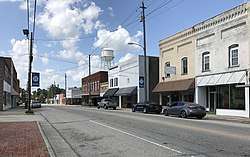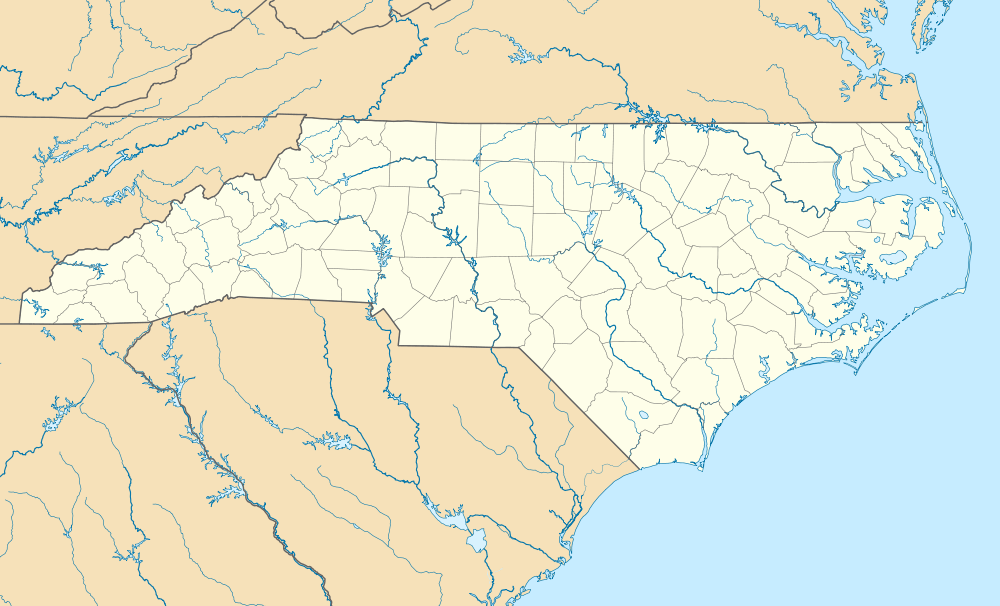Kenly, North Carolina
Kenly is a town in Johnston and Wilson counties in the U.S. state of North Carolina. It was named for John R. Kenly, Northern Division Superintendent of the Atlantic Coast Line Railroad, who later became president of the railroad in 1913. The population was 1,339 at the 2010 census,[5] down from 1,569 at the 2000 census.
Kenly, North Carolina | |
|---|---|
 | |
| Motto(s): "Friendly" | |
 Kenly  Kenly | |
| Coordinates: 35°35′35″N 78°7′38″W | |
| Country | United States |
| State | North Carolina |
| Counties | Johnston, Wilson |
| Area | |
| • Total | 1.75 sq mi (4.52 km2) |
| • Land | 1.74 sq mi (4.52 km2) |
| • Water | 0.00 sq mi (0.01 km2) |
| Elevation | 194 ft (59 m) |
| Population (2010) | |
| • Total | 1,339 |
| • Estimate (2019)[2] | 1,584 |
| • Density | 908.78/sq mi (350.81/km2) |
| Time zone | UTC-5 (Eastern (EST)) |
| • Summer (DST) | UTC-4 (EDT) |
| ZIP code | 27542 |
| Area code(s) | 919 |
| FIPS code | 37-35540[3] |
| GNIS feature ID | 1021028[4] |
| Website | www |
History
Boyette Slave House was listed on the National Register of Historic Places in 1979.[6]
Geography
Kenly is located in eastern Johnston County at 35°35′35″N 78°7′38″W (35.592967, -78.127360).[7] A small portion of the town extends into the southwest corner of Wilson County. U.S. Route 301 (Church Street) is the main road through the center of town; US 301 leads northeast 15 miles (24 km) to Wilson and southwest 14 miles (23 km) to Smithfield. North Carolina Highway 222 (Second Street) crosses US 301 in the center of Kenly; it leads northwest 13 miles (21 km) to Emit and southeast 9 miles (14 km) to Fremont. Interstate 95 runs along the northwest edge of Kenly, with access from Exit 107 (US 301); I-95 leads northeast 33 miles (53 km) to Rocky Mount and southwest 58 miles (93 km) to Fayetteville.
According to the United States Census Bureau, Kenly has a total area of 1.6 square miles (4.2 km2), of which 1.609 acres (6,513 m2), or 0.16%, are water.[5]
Demographics
| Historical population | |||
|---|---|---|---|
| Census | Pop. | %± | |
| 1890 | 137 | — | |
| 1900 | 260 | 89.8% | |
| 1910 | 726 | 179.2% | |
| 1920 | 827 | 13.9% | |
| 1930 | 965 | 16.7% | |
| 1940 | 1,095 | 13.5% | |
| 1950 | 1,129 | 3.1% | |
| 1960 | 1,147 | 1.6% | |
| 1970 | 1,370 | 19.4% | |
| 1980 | 1,433 | 4.6% | |
| 1990 | 1,549 | 8.1% | |
| 2000 | 1,569 | 1.3% | |
| 2010 | 1,339 | −14.7% | |
| Est. 2019 | 1,584 | [2] | 18.3% |
| U.S. Decennial Census[8] | |||
As of the census[3] of 2000, there were 1,569 people, 671 households, and 414 families residing in the town. The population density was 1,035.1 people per square mile (398.5/km2). There were 754 housing units at an average density of 497.4 per square mile (191.5/km2). The racial makeup of the town was 55.32% White, 40.60% African American, 0.25% Native American, 0.25% Asian, 2.29% from other races, and 1.27% from two or more races. Hispanic or Latino of any race were 3.57% of the population.
There were 671 households, out of which 32.0% had children under the age of 18 living with them, 36.8% were married couples living together, 20.0% had a female householder with no husband present, and 38.2% were non-families. 34.6% of all households were made up of individuals, and 13.9% had someone living alone who was 65 years of age or older. The average household size was 2.34 and the average family size was 3.02.
In the town, the population was spread out, with 28.1% under the age of 18, 8.5% from 18 to 24, 29.1% from 25 to 44, 20.4% from 45 to 64, and 13.9% who were 65 years of age or older. The median age was 36 years. For every 100 females, there were 90.4 males. For every 100 females age 18 and over, there were 82.8 males.
The median income for a household in the town was $20,865, and the median income for a family was $33,214. Males had a median income of $24,250 versus $17,917 for females. The per capita income for the town was $14,181. About 23.3% of families and 25.2% of the population were below the poverty line, including 26.5% of those under age 18 and 19.3% of those age 65 or over.
Education
- Glendale-Kenly Elementary
- North Johnston High School
Notable people
Culture
Kenly is the home of the Eastern North Carolina Church of God (Cleveland, Tennessee) State Executive Offices and Conference Center.
References
- "2019 U.S. Gazetteer Files". United States Census Bureau. Retrieved July 27, 2020.
- "Population and Housing Unit Estimates". United States Census Bureau. May 24, 2020. Retrieved May 27, 2020.
- "U.S. Census website". United States Census Bureau. Retrieved 2008-01-31.
- "US Board on Geographic Names". United States Geological Survey. 2007-10-25. Retrieved 2008-01-31.
- "Geographic Identifiers: 2010 Census Summary File 1 (G001): Kenly town, North Carolina". American Factfinder. U.S. Census Bureau. Archived from the original on February 13, 2020. Retrieved October 12, 2018.
- "National Register Information System". National Register of Historic Places. National Park Service. July 9, 2010.
- "US Gazetteer files: 2010, 2000, and 1990". United States Census Bureau. 2011-02-12. Retrieved 2011-04-23.
- "Census of Population and Housing". Census.gov. Retrieved June 4, 2015.
External links
| Wikimedia Commons has media related to Kenly, North Carolina. |